“We know this route network will not materialize overnight. But then again, neither did the Interstate Highway System.”
— Adventure Cycling’s Ginny Sullivan
Calling it a “very big milestone”, backers of the U.S. Bicycle Route System (USBRS) are celebrating a key decision that sets a course for creating the largest official bicycle route network in the world.
The system’s National Corridor Plan has just been approved by the American Association of State Highway and Transportation Officials (AASHTO). The corridor plan is a 50,000 mile network of 50-mile wide swaths that criss-cross the country and link key destinations (map below).
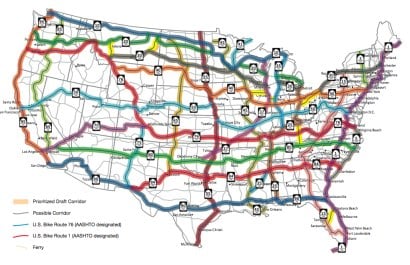
In an email today, the executive director of Adventure Cycling (the non-profit who has provided staff support on the project), Jim Sayer, wrote that AASHTO’s decision is a major milestone because it, “sets the framework for creating all the intercity, interstate routes, and there’s already interest and activity on that front.”

The effort to create a U.S. Bicycle Route System has been under development for four years and it has been a collaborative effort between federal and state transportation agencies and non-profit groups.
In a statement released today, John Horsley, executive director of AASHTO, praised the plan: “Bicycling is an increasingly popular transportation option that helps our environment and improves the quality of life for many Americans.”
Horsley (a member of the transportation “establishment” in America) also said that the approval means that now state DOT’s can work with local agencies to “begin establishing these routes throughout the United States”.
Adventure Cycling’s Ginny Sullivan (who I caught up with in Seattle back in September) said she’s already seen “tremendous interest” from states and nonprofits that want to work together and develop official routes.
“We know this route network will not materialize overnight,” said Sullivan. “But then again, neither did the Interstate Highway System.”
For more information on this exciting effort, visit AdventureCycling.org/USBRS.


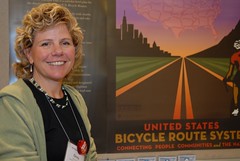
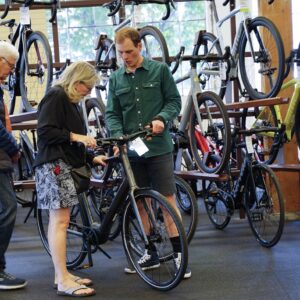
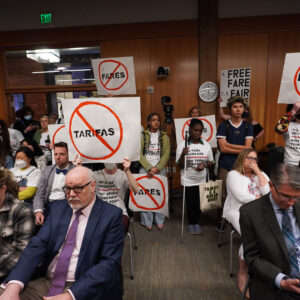

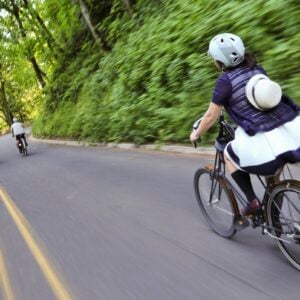
Thanks for reading.
BikePortland has served this community with independent community journalism since 2005. We rely on subscriptions from readers like you to survive. Your financial support is vital in keeping this valuable resource alive and well.
Please subscribe today to strengthen and expand our work.
Cool! Keep Up the Great Work Folks!
BTW… I still want that poster! That’s something I could proudly put up on a wall!
wow, I would love this. As I get more and more into distance riding, this would be amazing.
If I live long enough these bike routes would be wonderful for long trips. But with all the oil going to be gone in a few years we will be able to ride our bikes on the Interstates.
The Adventure Cycling vision doesn’t appear to be car free.
http://www.adventurecycling.org/routes/nbrn/thedream.cfm
This is a truly commendable effort but these routes will useful only a very hardy few.
I hope the backers of the U.S. Bicycle Route System will now champion the concept of an true Interstate Bikeway system. One that would be car free, ADA compliant, and comfortable for pedestrians.
We are about to see billions of federal dollars pumped into infrastructure. This may be the chance of a lifetime to see a real interstate bike freeway happen.
Not impressed. Gotta do better than this get-up in the Kingdom of Qatar.
sounds great but the best use of the bicycle is in the urban environment, not the interurban/ interstate one, this is basically purely recreational…
Burr – #6 – I’m with you.
I’ve ridden multi-thousand mile bike rides and will again, ’cause it’s a wonderful thing. Adventure Cycling, however, is about recreation (note the routes which mostly follow extant ACA ones and skip connecting so many other cities/areas). Any major amount of money going into this would be much better spent bringing any given metropolitan area back to the bike age and helping to make bike use a preferable option for more Americans (most of whom are not gonna be doing any trans-am/interstate rides soon).
Like Burr said, bike is optimal for city use as transportation. But we do need more of the focus ACA brings, for sure. If AASHTO’s stamp gives more legitimacy to state and Fed acceptance and subsequent creation of facilities for the bike, then that’s what’s really worth attention here for the greater community.
I don’t agree that such an interstate system is purely recreation. I’ve done a few cross-state trips and while my journey was vacaton travel, I have met many folks traveling such distances in order to get somewhere. Those folks had the time to go by bike but at least a couple chose to take that time because bicycling was the most appealing form of transportaion -not recreation- to them.
I think this is a great first step but having traveled on some of the already established interstate routes – Pacific Coast Bike Route, Souther Tier – I do think there needs to be more work done on establishing standards for what that route looks like on the ground. Who cares if the route is offical and marked for bikes if there is no shoulder, rumble strips and high volume, high speed traffic?
I don’t agree that such an interstate system is purely recreation. I’ve done a few cross-state trips and while my journey was vacaton travel, I have met many folks traveling such distances in order to get somewhere. Those folks had the time to go by bike but at least a couple chose to take that time because bicycling was the most appealing form of transportaion -not recreation- to them.
I think this is a great first step but having traveled on some of the already established interstate routes – Pacific Coast Bike Route, Souther Tier – I do think there needs to be more work done on establishing standards for what that route looks like on the ground. Who cares if the route is offical and marked for bikes if there is no shoulder, rumble strips and high volume, high speed traffic?
Highways were designed for cars. I don’t need to feel safe on the highway. I need to be safe on surface streets.
Long-distance cycling is not for everyone. While this is a baby step in a good direction, I won’t be satisfied until we start seeing Federal sponsorship of major URBAN infrastructure change that favors bike riders and pedestrians. In every US city. I have grown tired of waiting patiently for incremental change. Life is too short for baby steps.
A car-free or greatly car-reduced world — with people living more localized lives and shunning hyper-mobility — is what I want to see. From where I stand, there’s no point in pretending a more moderate view anymore. I don’t feel moderate about it.
While it’s nice to see this be a part of the ongoing discussion, I don’t think improving my chances of riding 3,000 miles safely from coast to coast will do much for improving my chances of riding five miles to get home safely.
A common theme with the posts here on BikePortland is that recreation is an unimportant part of the cycling infrastructure. The work-commute routes are the only priority and the rest is just fluff. So if you’re not heading to work in the cold rain through greasy puddles and dodging broken bottles in the urban jungle then you are just a poser, a sunny day recreationalist. You have no business here… move along.
I humbly submit that getting to/from work is only part of the puzzle. When does it stop being worthwhile? Does a route to a restaurant constitute an important route?
Having routes or methods of transport that connect activities not necessarily related to your paycheck is an essential and important thing. Why do I still have a old car depreciating its last dollars in the driveway? Because I cannot handily get to the beach & mountains when I have the desire to do so. And, realistically, when friends and family come to visit, they’re not inclined to go on a 2 hour transit mystery tour when a 20 minute car ride is available. That said, I did pick up one of my friends on my Xtracycle with his luggage. Sorry, getting way off topic here.
My vote is not either or for routes, it’s yes I want excellent cycling infrastructure all around.
In some cases, it’s important to draw the distinction between recreation and more utility-minded transportation routes… but we should do so very carefully.
Consider the Springwater Trail. That’s a great example of a route initially conceived as a recreational route, but it has now become an essential transportation artery for thousands of bike commuters.
In my mind, any effort raise the respect and quality of biking is something worth supporting.
Yes, we should be mindful of how money is spent, but in this case, it’s a project that is many years in the making and it’s not money coming from a pot previously allocated for some other reason.
It’s also important to note that, while AASHTO is supporting this effort, they are also lobbying congress to build more highways and they are widely considered the “other guys” in conversations about how to improve our country’s transportation system.
This is very cool. I saw the map at the Pro Walk Pro Bike Conference up in Seattle. Maybe with a national network of “high/bike/ways” we can get the cash allocated for all those overpasses and underpasses like federal highways.
Beth – I understand that long-distance cycling is not for everyone, but staying in one place is also not for all. I love Portland and consciously consider proximity in the myriad choices that influence my daily routine, but I was also born with an instiable appetitite for travel. If I had to live a completely localized life, I would wither. I resist using fossil fuels (planes and cars) and am happily using my bike to satisfy my nomadic tendancies. In fact I believe more and more the bike is the perfect vehicle for that so, I am extremely happy to hear some work is being done and believe it is as important as the work craft bike-/ped frienldy urban areas. Why choose between having improved urban and interstate bike facilities – I’m hopeful that we can have both.
I got excited about this then realized, that it probably won’t end up as dedicated bicycle/pedestrian trail right of ways, but only a median strip on the side of the road filled with old nails and broken glass…
“then realized, that it probably won’t end up as dedicated bicycle/pedestrian trail right of ways,”
KWW… i wouldn’t jump to any conclusions yet about what these might end up as. That is still remaining to be seen.
I would, however, urge you to be excited and to stay tuned for ways you can help impact the quality of the routes.
if we all sit back and remain gloomy about the prospects of bike infrastructure, I can guarantee you nothing exciting will ever happen ;-).
this is potentially a huge opening in the quest for equality of bikes and cars and we should take the utmost advantage of it.
I’m still confused as to what exactly such a “National Bike Route System” would actually entail. Is it a network of actual multiuse paths or just a plan to add signs to already existing state highways?
ES – #18 – Overwhelmingly the latter: signage and maps utilizing extant highways and roads.
You want multiuse paths (MUPs)? Then yer lookin’ primarily at rails-to-trails, which ACA doesn’t do a lot of and does not appear to have included any obvious components of in their work with AASHTO.
Rails-to-trails, albeit empowered by the sharing of organizational resources of national and regional advocates, seems almost always to be very home-grown. That is, it ends up generated locally by fired-up true-believers who wrest funding and support from government (and sometimes local planners are the true-believers!) and donors.
The NBRS, if modeled on the two original National Bike Routes and ACA’s historical practice, is not about transportation. Look at the proposed transits of Oregon or California: The coast? I love the coast and have ridden from here to there dozens of times, but headin’ right down the Willamette Valley or the central valleys (Sacramento, San Joaquin) of California makes much more sense (and are still beautiful rides). The route which looks kinda like US97 east of the Cascades looks more reasonable…
In general, yeah! Of course, more people on bikes on more bike infrastructure is better. ACA and AASHTO, however, don’t have a track record that involves dedicated bikeways.
Wouldn’t that be great, though? Like Jonathan says, we should be ready to be excited and pitch in.
Are Hawaii and Alaska excluded from the US [Bike Route System] now?
Thanks for the coverage and all the comments. Regarding concerns about the routes and the types of facilities, please look at Jonathan’s earlier posts and Adventure Cycling’s responses.
(Example: comments # 11 and #15 on http://bikeportland.org/2008/09/04/in-seattle-an-update-on-the-us-bicycle-route-system/)
For example, we’ve noted repeatedly that the corridors (and hence the routes) are not fixed and could be flexed or supplemented if there is enough interest — that we would be thrilled for routes to go through cities. Also, we have included rail-trails, hard-pack trails and low volume county roads in the mix of potential route facilities. (This was the subject of much discussion and a big breakthrough for AASHTO, which focuses on highways — all part of the learning process.) The great thing about this plan and process is that the states and non-profits and individuals can create a great urban/suburban/rural system with all types of facilities, including trails. (That’s why one of the partners in this is the East Coast Greenway Alliance, dedicated to a completely separate multi-modal trail from Florida to Maine.)
Check out the supporting materials and feel free to contact Ginny Sullivan at gsullivan@adventurecycling.org with your ideas.
Also, per #20 (Todd B), Hawaii and Alaska are included — see the maps at http://www.adventurecycling.org/usbrs
Hi Todd,
No Alaska and Hawaii are not excluded – we have developed corridors for them. One thing to note is that by definition, two or more aligned states will apply for AASHTO designation at one time (this is so routes connect across state lines). Because Alaska and Hawaii have no neighboring states to apply with, we will have to consider how they interact with the rest of the USBRS. This is one of the on-going projects the Task Force on US Bicycle Routes will address in the coming months.
I do a lot of city-to-city riding on state highways, but a dedicated system with pre-planned routes that are designated as either bike-friendly or bike-only would be a lot easier than the way I have had to do it up until now. This will greatly reduce the amount of time on Google Earth and Bike Route Toaster using satellite photos
I really like the graphic for this project, but I would say that it needs more bike rider. We’re in this together – it’s no longer about the individual driving (or riding) alone!!!